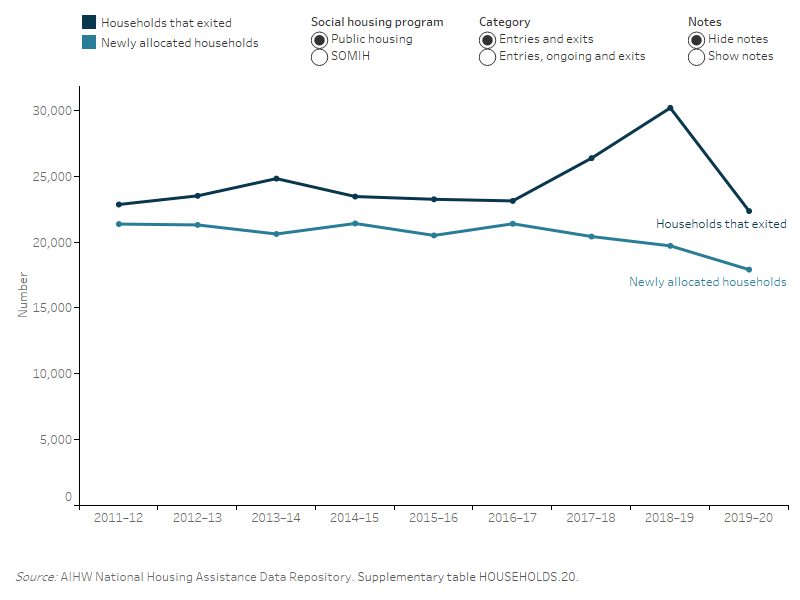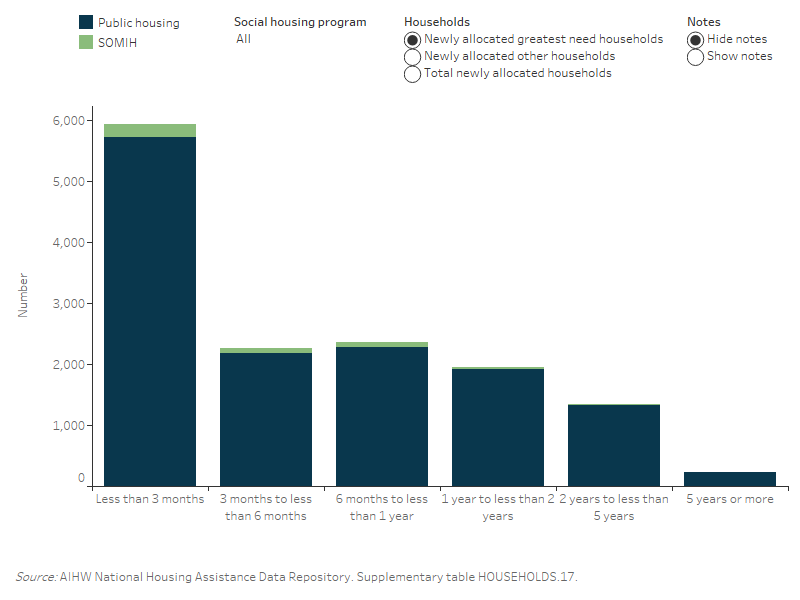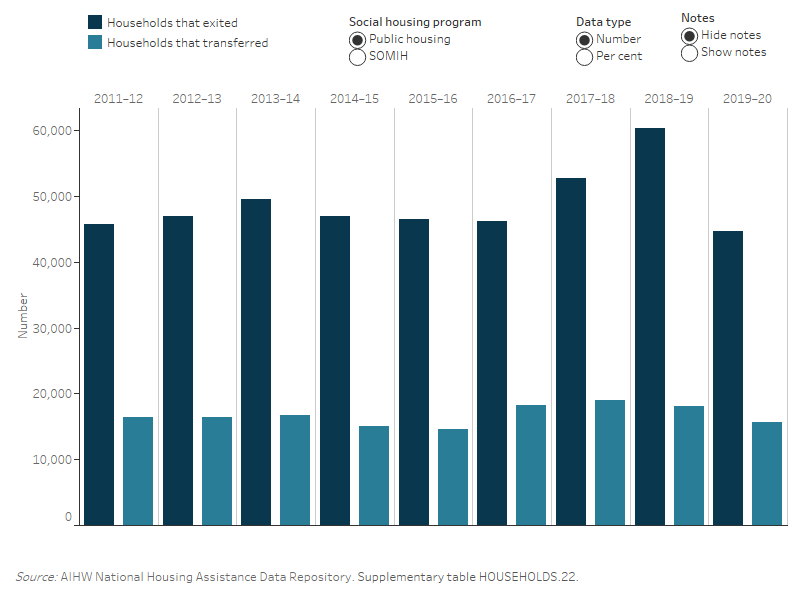Entries, exits, transfers and wait times
On this page:
Quick facts
- During 2019–20, 34,100 households were newly allocated to public housing, community housing and SOMIH dwellings, a decrease from 42,300 new allocations in 2018–19.
- Over two-thirds (68%) of newly allocated households in public housing were in 1 bedroom or 2 bedroom dwellings, compared with 25% of SOMIH households.
- For SOMIH, 78% of newly allocated households were in separate houses.
- Over two-thirds (68%) of new allocated public housing households that spent less than three months on a waiting list were allocated either one or two bedroom housing.
Over time, people may be allocated social housing, exit a social housing program, or move from one social housing dwelling to another within the same program (Figure 1). This section presents key data about these entries, exits and transfers. Further detailed analysis of newly allocated social housing for priority groups (special needs and greatest need) and time spent on the waiting list are presented in subsequent sections.
Data on newly allocated households for Indigenous community housing were not available.
Figure 1: Entries, exits and ongoing households

Households entering social housing
Entry into social housing is dependent upon eligibility, with priority needs having an influence on the pathway of people into social housing. Generally, as dwellings become available they are offered to priority applicants, then other waiting list applicants whose eligibility and location requirements match the dwelling (Powell et al. 2019).
In 2019–20, there were 34,100 newly allocated households across public housing, community housing and SOMIH programs. More than half of these were new allocations to public housing (17,900 households), with 15,100 allocated to community housing and 1,100 to SOMIH (Supplementary table HOUSEHOLDS.8).
The number of new entries to public housing remained relatively stable 2011–12 and 2018–19, at around 20,000 to 21,000 newly allocated households each year but decreased to 17,900 in 2019–20 (Figure ENTRIES, ONGOING and EXITS.1; Supplementary table HOUSEHOLDS.20).
Figure ENTRIES, ONGOING AND EXITS.1: Ongoing, newly allocated and exited households, by public housing and SOMIH, 2011–12 to 2019–20
Figure ENTRIES, ONGOING AND EXITS.1: Ongoing, newly allocated and exited households, by public housing and SOMIH, at 2011–12 to 2019–20. This line graph shows the changes in newly allocated entries, ongoing and exits households from 2011–12 to 2019–20 for public housing and SOMIH. This line graph shows that ongoing households make up the highest number of households for both public and SOMIH. Ongoing households in public housing decreased from 323,400 in 2011–12 to 289,600, in 2019–20 while SOMIH increased from 9,700 in 2011–12 to 13,800 in 2019–20. For public housing, newly allocated households declined from 21,400 in 2011–12 to 17,900 in 2019–20.

For SOMIH, the 1,100 newly allocated households in 2019–20 was a decrease from 1,400 in 2018–19 (Supplementary table HOUSEHOLDS.8).
For community housing, the number of newly allocated community housing households has been increasing over time, from 12,400 in 2013–14 to 21,300 in 2018–19, yet decreased to 15,100 in 2019–20 (Supplementary table HOUSEHOLDS.8). The increase from 2013–14 to 2018–19, was in part due to the transfer of dwellings from public housing to community housing in NSW in 2018–19 and South Australia in 2017–18.
Characteristics of newly allocated households
For public housing, newly allocated households were mostly single adults (47%) and sole parents with dependent children (22%). Other key features of newly allocated households in public housing for 2019–20 include (Supplementary tables HOUSEHOLDS.3 and HOUSEHOLDS.10):
- for almost 3 in 5 households, the main tenant was female (57% female and 41% male)
- 1 in 4 households were Indigenous (25%)
- for around 1 in 4 (7%) households the main tenant was 70 years of age and over
- around one-third (29%) households had a member with disability whereas 38% of ongoing households had a household member with a disability.
For SOMIH, newly allocated households were most commonly group and mixed composition households (34%) and sole parents with dependent children (33%). In contrast to the other programs, newly allocated households in SOMIH were less likely to be single adults (13%) and were more likely to have a female main tenant (70%) (Supplementary table HOUSEHOLDS.10).
Data on newly allocated households for community housing and Indigenous community housing were not available.
Housing features of new allocations
In 2019–20, newly allocated households in the public housing program were more likely to be dwellings with fewer bedrooms (36% were 1 bedroom, 32% were 2 bedrooms, 27% were 3 bedrooms and 5% were 4 or more bedrooms). For SOMIH, over half of newly allocated households were 3 bedroom dwellings (57%), with a further 21% in 2 bedroom and 18% in 4 or more bedrooms (Supplementary table HOUSEHOLDS.12).
Newly allocated households were also less likely to be in separate houses. In 2019–20 (HOUSEHOLDS.11 and DWELLINGS.7):
- For public housing, 25% of newly allocated households were in separate houses compared with 37% of all public housing dwellings.
- For SOMIH, 78% of newly allocated households were in separate houses compared with 82% of all SOMIH dwellings.
New allocations and waiting times
The waiting times for social housing programs differ between different areas across Australia, with waiting times for particular high demand city areas often being far greater than other areas (NSW government 2018). They can also differ based on the size of the dwelling needed, and differ for people deemed to be in a priority group for social housing (such as those experiencing homelessness or with disability).
Time spent on the waiting lists for social housing can be measured by looking at newly allocated households. Total waiting list times in the following section for those in greatest need were calculated from the date of greatest need determination to the housing allocation date. For other households not in greatest need, the waiting list time is calculated from the housing application date to housing allocation. For the new special needs households, the waiting time represents the period from the housing application to the housing allocation.
Of all newly allocated households in 2019–20 (Supplementary table HOUSEHOLDS.18):
- For public housing, 36% spent less than six months on the waiting list; 24% spent less than three months waiting.
- For SOMIH, over half (55%) of newly allocated households spent less than six months on the waiting list; 41% spent less than 3 months waiting.
Waiting time data for both community housing and Indigenous community housing were unavailable.
Greatest need and waiting times
An assessment of greatest need status is made of households applying for social housing (public housing, SOMIH and community housing) and largely relates to experiences of homelessness. For more detailed information, see Priority groups: greatest and wait lists section.
In 2019–20, among newly allocated households (Figure WAITLIST.1) (Supplementary table HOUSEHOLDS.17):
- The majority of greatest need households (75%, or 10,200 households) received public housing within one year of the household being on the waiting list; 42% spent less than 3 months waiting.
- By contrast, far fewer other households who were not in greatest need (39% or 1,600) were allocated housing within a year on the waiting list; 19% spending less than 3 months waiting.
- Around two in five (44%) newly allocated households not in greatest need, spent more than 2 years on the waiting list before public housing allocation.
For SOMIH, newly allocated households in greatest need were more likely than other households to be allocated housing faster. In 2019–20 (Figure WAITLIST.1) (Supplementary table HOUSEHOLDS.17):
- Around 88% of newly allocated SOMIH households in greatest need spent less than 12 months on waiting lists; 52% spent less than 3 months waiting.
- In comparison, 47% of newly allocated households not in greatest need were on the SOMIH waiting list for less than 12 months; 21% spending less than 3 months waiting.
- Around 12% of newly allocated SOMIH households in greatest need spent more than 1 year on the waiting list before allocation.
Figure WAITLIST.1: Waiting time of newly allocated households, by greatest need status and public housing and SOMIH, 2019–20
Figure WAITLIST.1: Waiting time of newly allocated households, by greatest need status for public housing and SOMIH, 2019–20. The stacked bar graph shows the highest number of new allocated greatest need household in both public housing (5,700) and SOMIH (200) spent less than 3 months on the waiting list. For both public housing (1,200) and SOMIH (50), the highest number of new allocated other households spent 2 years to less than 5 years on a wait list.

Special needs and waiting times
Households seeking assistance from social housing providers often have members with special needs. Some households may have multiple special needs. The definition of special needs is different for different social housing programs. For more detailed information, see Priority groups and wait times.
For the newly allocated special needs households, the waiting list time represents the period from the housing application to the housing allocation. In 2019–20, the time spent on the waiting list for special needs households allocated public housing varied, with around (Supplementary table HOUSEHOLDS.18):
- 2,400 (23%) households waiting for less than 3 months
- 3,000 (29%) households waiting between 3 months and less than 1 year
- 3,900 (38%) households waiting between 1 year to less than 5 years, and
- 1,000 (or 10%) households waiting for more than 5 years.
Number of bedrooms and waiting times
The wait times for social housing programs differ depending upon the number of bedrooms allocated to a household. Of all newly allocated households in 2019–20 (Supplementary table HOUSEHOLDS.19):
- Over two-thirds (37%) of public housing households that spent less than three months on a waiting list were allocated 1 bedroom housing; a lower proportion (27%) were allocated 3 bedrooms.
- A lower proportion of SOMIH households that spent less than three month on a waiting list received 1 bedroom housing (4%) compared with 57% that received 3 bedrooms.
- For public housing, a higher proportion of households that spent 5 years or more on a waiting list received 1 bedroom housing (40%) whereas 22% received 3 bedrooms.
Waiting time data for both community housing and Indigenous community housing were unavailable.
Households exiting social housing
Households may exit social housing for a number of reasons, for example, the occupant secured private accommodation, eviction or the occupant was no longer eligible for social housing based on their income.
In 2019–20, there were around 22,400 households that exited public housing and around 1,200 households that exited from SOMIH (Supplementary table HOUSEHOLDS.20). In recent years, there have been more households that exited public housing compared with newly allocated households into public housing. In 2019–20, 22,400 households exited while 17,900 households were newly allocated to public housing (Supplementary table HOUSEHOLDS.20). Note: 'Exits' are those households that exited the specific housing program during the reference year. Households that ‘Exit’ do not include households that relocate within a housing program.
In 2019–20, fewer households exited SOMIH compared with the previous year (1,100 compared with 1,300 in 2018–19). In 2019–20, the number of households exiting SOMIH was similar to the number of newly allocated households (1,100) (Supplementary table HOUSEHOLDS.20).
Households transferring dwellings
Occupants may transfer between dwellings within the same social housing program if circumstances change, for example, change to household composition resulting in overcrowding, occupants experience family violence and need to move or through stock renewal and re-development. Transfers may be initiated by the tenant or the housing provider and can include mutual exchanges of properties between eligible tenants.
During 2019–20, 3% of public housing households and 2% of SOMIH households transferred—or were relocated—to a different dwelling within the same housing program (Supplementary table HOUSEHOLDS.22).
Key details about households that transferred dwellings within public housing include (Supplementary table HOUSEHOLDS.21):
- for 2 in 3 households, the main tenant was female (68% female and 30% male)
- almost half of households had a main tenant aged over 50 years (47%)
- 38% of households had a member with disability, while 48% did not (14% not stated)
- most households comprised of single adults (40%), followed by sole parents with dependent children (19%).
In 2019–20, the Northern Territory had a comparatively higher proportion of households that transferred within public housing (5%, or 200 households) while Tasmania had a lower proportion (1%, or 100 households). New South Wales had the largest number of households that transferred (2,400), followed by Victoria (1,900) (Figure TRANSFERS AND EXITS.2; Supplementary table HOUSEHOLDS.22).
Figure TRANSFERS AND EXITS.2: Households by transfer and exit status, public housing and SOMIH, by states and territories, 2011–12 to 2019–20
Figure TRANSFERS AND EXITS.2: Households by transfer and exit status, by public housing and SOMIH, 2011–12 to 2019–20. This vertical bar graph shows that nationally the number of public housing and SOMIH households that exited were higher than those that transferred, from 2011–12 to 2019–20. In 2011–12, 45,700 public housing households exited and 16,400 households transferred; in 2019–20, 44,700 households exited and 15,700 transferred. In 2011–12, around 1,300 SOMIH households exited and 600 transferred; in 2019–20, 2,300 households exited and around 600 transferred.

- NSW Government, Department of Communities and Justice 2018. Waiting times for social housing. Last published 24 January 2018. Viewed 12 March 2020.
- Powell A, Meltzer A, Martin C, Stone W, Liu E, Flanagan K, Muir K and Tually S 2019. The construction of social housing pathways across Australia. AHURI Final Report 316. Melbourne: Australian Housing and Urban Research Institute Limited.


